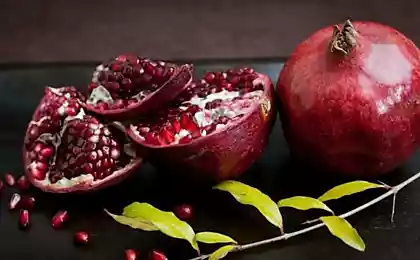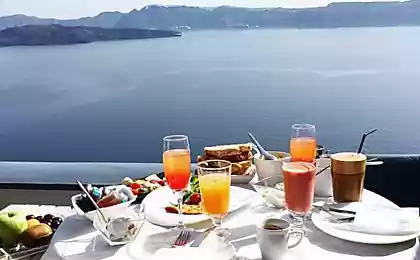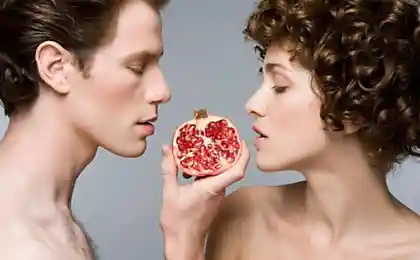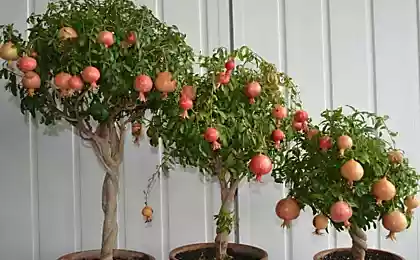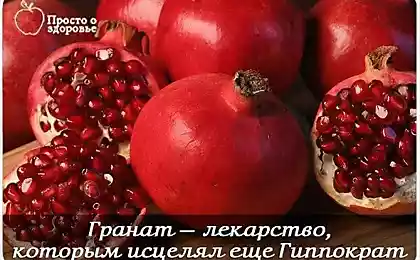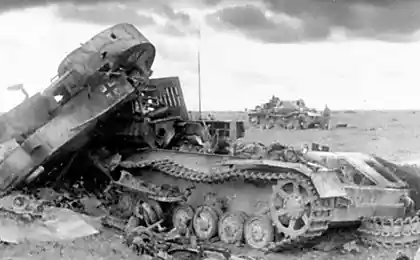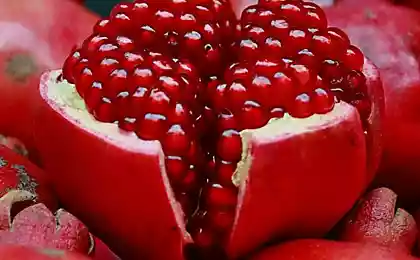249
A grenade in our Sadhu
Pomegranate is a southern plant, it likes heat and ripens in warm areas as early as mid-autumn, if not later. Today, there are also frost-resistant and precocious varieties, but growing a pomegranate in the middle strip in the open ground is an occupation for extremes.
Depending on the variety and type of pomegranate, as well as the region in which it was grown, the berries can be sour or sweet.
Sweet taste.They usually have pomegranates grown in Turkmenistan, Azerbaijan near the Talysh Mountains and Nachikhevan, Central Asia.
Sour taste.Karabakh and Ganjavin, West Azerbaijan grenades. Georgian can also be recognized by the sour taste and pink flesh with white, slightly pink grains.
Pomegranate (Punica)familyDerbennikov. These are shrubs or small trees up to 6 m high. Pomegranate belongs to deciduous cultures. Its branches are thin and there are thorns on them. Pomegranate has 2 main types of flowers: those that form a ovary (in the form of a jug), and those that do not form fruits (in the form of a bell). Infertile flowers can also be distinguished by their small size, short pistil. These flowers fall quickly. There is also an intermediate form of flowers. The flowers are orange-red.
The pomegranate tolerates drought well and can withstand a short-term drop in temperature to -17 ° C, but at this temperature it suffers shoots on which fruits are formed. Therefore, it is grown mainly in the south of Russia.
Now there is a lot of controversy about growing pomegranate in Central Russia. With a good shelter of pomegranates, of course, can live more than one winter, but whether it will ever bloom is a big question. Below is a photo of a pomegranate planted in a garden at the age of two from a pot. He winters in the suburbs more than one winter in a row, but has never bloomed.
However, as already mentioned, the craftsman from Shebekino has overcome these difficulties and successfully grows pomegranates in his city, as can be seen in the video at the end of the article.
Landing of a grenade
An important condition for growing pomegranate is the total amount of active temperatures of at least 3,000 and the winter temperature of about 15 ° C. Heat is the key to large and good fruits.
Pomegranate is undemanding for soils. It can grow even on wet soils. But still it is necessary to prepare the ground, arrange drainage, so that moisture is drained, and not stagnated. Drainage can be crushed stone, ceramzite, less often gravel. Pomegranate soil may have an alkaline reaction and loam structure, but in this case it should be properly charged with organic and mineral fertilizers.
The planting pit is dug in the same way as for many fruit trees (60x70 cm), a fertile layer of soil (about 15 cm) is poured into the bottom, then humus mixed with the ground (somewhere a little more than a bucket). Spread the roots and gently sprinkle the earth.
After planting, fly well and mulch the soil with dry weeds, straw or humus. This will help moisture stay longer in the soil.
If you cover a grenade for the winter, it makes sense to plant a seedling under an inclination of 60-45 ° to the south side.
Care for a grenade
RelaxationIt should be carried out in the first years after landing. Especially useful is loosening in the growing season.
wateringPomegranates are watered moderately, especially during the growing season. From the second growing season, the slightest overdrying of the soil will lead to cracking of the pomegranate fruits.
Shelter for winter- you can pull the branches with the help of bags during the calm period of the plant (winter). If the seedling was planted at an angle, in autumn it bends to the ground and is insulated with the earth like grapes. Starting from the top, the plant is gently bent to the ground, while about 4 shovels of earth are poured on the top, after which the whole plant is filled with earth from between rows of a layer of about 20 cm. In spring, when the threat of frost passes, the plant is gradually released from the bottom to the top.
If shelter for the winter is not planned, an annual seedling should be dipped with earth to a height of about 15 cm.
Many gardeners also insulate pomegranate seedlings with one or more mounted tires.
Crown formation and pomegranate trimmingThe optimal form for a pomegranate is a bush form, where the plant has a maximum of 6 trunks. This form of the bush helps to avoid injury to the plant in the case of its shelter for the winter. The plant is trying to give a inclined fan form. But with strong vegetation, thickening of the plant and the appearance of branches that can break or grow inside are inevitable. To do this, remove the interfering twigs. Root and stamped grass should also be removed.
Like many fruit plants, pomegranate ages and needs to be rejuvenated. This usually happens once every 20 years. To do this, all branches above the ground are pruned, thereby stimulating the growth of new young and increasing the number of crops.
Fertilization- the bulk of fertilizers is applied to the ground before planting, but in case of soil poverty, from mid-June, the plant begins to be fed with phosphorus-potassium or nitrogen-containing fertilizers. In summer, you can fertilize with liquid fertilizers together with watering. In autumn, when you dig up the barrel circles, also apply fertilizer.
Reproduction of the grenade is multiplyingcutting(vegetative method) andseeds.
Seed methodTake seeds from a fresh, well-ripened fruit, you do not need to clean. Distribute the seeds over the surface of moist soil, sprinkling the earth with a layer of about 1.5 cm. While the seeds germinate, the soil should not be allowed to dry out. When the seeds germinate and reach a height of 3 cm, they are dived or transplanted so that the distance between the shoots is at least 4 cm. When the shoots grow so much that there are no gaps between shoots, they dive again.
Cuttingcuttings are cut from annual stiffened shoots of young plants. The cutting size is about 25 cm. Growing can also be used for this purpose. To root the cutting, areas well fertilized and drained are used. Root the cutting should be heated to 12 ° C soil to a depth of about 10 cm. Above the surface of the soil should remain 1 internode. Green twigs take root in late May - early June.
In the south of Russia (some regions of the Kuban) and in the Crimea, the fruits begin to be harvested in October. They have reached their maximum maturity, the grains are full of sugars, and the skin acquires a rich red or yellow-pinkish color.
Grenades of full ripeness can crack, for storage you need to guess with the collection time until this point.
The pomegranate is perfectly stored and retains freshness for a long time. Fruits cannot be stored at sub-zero temperatures, otherwise they can rot. Optimal will be a ventilated room with an air temperature of + 2 ° C.
In the world there are many different varieties of this yet southern plant. Every country loves its own variety of pomegranate, but there are also well-known varieties, loved by many. Varieties of pomegranate are divided into those with hard seeds in juicy grains, and varieties with soft seeds. Hard seeds are considered a sign of poor quality. It's like an apple tree and a grafted apple tree. Quality varieties with soft seeds are very capricious and require no less care than infants. But the quality of their fruits is amazing.
Grades "Guleisha pink" and "Guleisha red"
Guleysha (also called Gulosha) is the best variety cultivated in Azerbaijan. Fruits have an elongated round shape, the skin is thin. In Guleisha pink it is pink, and in Guleisha red - carmine-red color with divorces (stripes) at the base of the fruit. Grains are juicy, dark crimson color. Both varieties have a sweet and sour taste.
Class "Ak Dona Crimean"
Excellent variety for cultivation in the vicinity of the Crimea. It is grown even in the steppe part of the Crimea, but requires shelter for the winter. It is distinguished by large oval fruits. You will recognize the variety by its creamy thin skin with red spots and blush on one side (usually the south). His neck is short and thick. The taste of the grains is sweet, with barely noticeable sourness, the grains themselves are pink-red. In the middle lane, I did not meet a gardener who would grow pomegranates of this variety, but if you can buy fruits of this variety on the market without cheating, they deliver a lot of taste impressions. The gardens are easy to grow, with excellent taste of fruits.
Kizil-anor.
The variety is early ripe, cultivated in Uzbekistan. Plus the grades in his precociousness. In early October, you can already harvest the fruits - from small to large. The skin is pink-scarlet, the grains are red, medium-sized and sweet-sour to taste.
Nana grenade.
Like many fruit crops, pomegranate has a dwarf form that is usually grown as a houseplant – Punica granatum nana. It pleases with flowers and bears fruit almost all year round, already with a growth of 40 cm, you can get a good harvest of 7-10 fruits, then more. The fruits are quite edible, their diameter is up to 5 cm.
Source: www.7dach.ru
Depending on the variety and type of pomegranate, as well as the region in which it was grown, the berries can be sour or sweet.
Sweet taste.They usually have pomegranates grown in Turkmenistan, Azerbaijan near the Talysh Mountains and Nachikhevan, Central Asia.
Sour taste.Karabakh and Ganjavin, West Azerbaijan grenades. Georgian can also be recognized by the sour taste and pink flesh with white, slightly pink grains.
Pomegranate (Punica)familyDerbennikov. These are shrubs or small trees up to 6 m high. Pomegranate belongs to deciduous cultures. Its branches are thin and there are thorns on them. Pomegranate has 2 main types of flowers: those that form a ovary (in the form of a jug), and those that do not form fruits (in the form of a bell). Infertile flowers can also be distinguished by their small size, short pistil. These flowers fall quickly. There is also an intermediate form of flowers. The flowers are orange-red.
The pomegranate tolerates drought well and can withstand a short-term drop in temperature to -17 ° C, but at this temperature it suffers shoots on which fruits are formed. Therefore, it is grown mainly in the south of Russia.
Now there is a lot of controversy about growing pomegranate in Central Russia. With a good shelter of pomegranates, of course, can live more than one winter, but whether it will ever bloom is a big question. Below is a photo of a pomegranate planted in a garden at the age of two from a pot. He winters in the suburbs more than one winter in a row, but has never bloomed.
However, as already mentioned, the craftsman from Shebekino has overcome these difficulties and successfully grows pomegranates in his city, as can be seen in the video at the end of the article.
Landing of a grenade
An important condition for growing pomegranate is the total amount of active temperatures of at least 3,000 and the winter temperature of about 15 ° C. Heat is the key to large and good fruits.
Pomegranate is undemanding for soils. It can grow even on wet soils. But still it is necessary to prepare the ground, arrange drainage, so that moisture is drained, and not stagnated. Drainage can be crushed stone, ceramzite, less often gravel. Pomegranate soil may have an alkaline reaction and loam structure, but in this case it should be properly charged with organic and mineral fertilizers.
The planting pit is dug in the same way as for many fruit trees (60x70 cm), a fertile layer of soil (about 15 cm) is poured into the bottom, then humus mixed with the ground (somewhere a little more than a bucket). Spread the roots and gently sprinkle the earth.
After planting, fly well and mulch the soil with dry weeds, straw or humus. This will help moisture stay longer in the soil.
If you cover a grenade for the winter, it makes sense to plant a seedling under an inclination of 60-45 ° to the south side.
Care for a grenade
RelaxationIt should be carried out in the first years after landing. Especially useful is loosening in the growing season.
wateringPomegranates are watered moderately, especially during the growing season. From the second growing season, the slightest overdrying of the soil will lead to cracking of the pomegranate fruits.
Shelter for winter- you can pull the branches with the help of bags during the calm period of the plant (winter). If the seedling was planted at an angle, in autumn it bends to the ground and is insulated with the earth like grapes. Starting from the top, the plant is gently bent to the ground, while about 4 shovels of earth are poured on the top, after which the whole plant is filled with earth from between rows of a layer of about 20 cm. In spring, when the threat of frost passes, the plant is gradually released from the bottom to the top.
If shelter for the winter is not planned, an annual seedling should be dipped with earth to a height of about 15 cm.
Many gardeners also insulate pomegranate seedlings with one or more mounted tires.
Crown formation and pomegranate trimmingThe optimal form for a pomegranate is a bush form, where the plant has a maximum of 6 trunks. This form of the bush helps to avoid injury to the plant in the case of its shelter for the winter. The plant is trying to give a inclined fan form. But with strong vegetation, thickening of the plant and the appearance of branches that can break or grow inside are inevitable. To do this, remove the interfering twigs. Root and stamped grass should also be removed.
Like many fruit plants, pomegranate ages and needs to be rejuvenated. This usually happens once every 20 years. To do this, all branches above the ground are pruned, thereby stimulating the growth of new young and increasing the number of crops.
Fertilization- the bulk of fertilizers is applied to the ground before planting, but in case of soil poverty, from mid-June, the plant begins to be fed with phosphorus-potassium or nitrogen-containing fertilizers. In summer, you can fertilize with liquid fertilizers together with watering. In autumn, when you dig up the barrel circles, also apply fertilizer.
Reproduction of the grenade is multiplyingcutting(vegetative method) andseeds.
Seed methodTake seeds from a fresh, well-ripened fruit, you do not need to clean. Distribute the seeds over the surface of moist soil, sprinkling the earth with a layer of about 1.5 cm. While the seeds germinate, the soil should not be allowed to dry out. When the seeds germinate and reach a height of 3 cm, they are dived or transplanted so that the distance between the shoots is at least 4 cm. When the shoots grow so much that there are no gaps between shoots, they dive again.
Cuttingcuttings are cut from annual stiffened shoots of young plants. The cutting size is about 25 cm. Growing can also be used for this purpose. To root the cutting, areas well fertilized and drained are used. Root the cutting should be heated to 12 ° C soil to a depth of about 10 cm. Above the surface of the soil should remain 1 internode. Green twigs take root in late May - early June.
In the south of Russia (some regions of the Kuban) and in the Crimea, the fruits begin to be harvested in October. They have reached their maximum maturity, the grains are full of sugars, and the skin acquires a rich red or yellow-pinkish color.
Grenades of full ripeness can crack, for storage you need to guess with the collection time until this point.
The pomegranate is perfectly stored and retains freshness for a long time. Fruits cannot be stored at sub-zero temperatures, otherwise they can rot. Optimal will be a ventilated room with an air temperature of + 2 ° C.
In the world there are many different varieties of this yet southern plant. Every country loves its own variety of pomegranate, but there are also well-known varieties, loved by many. Varieties of pomegranate are divided into those with hard seeds in juicy grains, and varieties with soft seeds. Hard seeds are considered a sign of poor quality. It's like an apple tree and a grafted apple tree. Quality varieties with soft seeds are very capricious and require no less care than infants. But the quality of their fruits is amazing.
Grades "Guleisha pink" and "Guleisha red"
Guleysha (also called Gulosha) is the best variety cultivated in Azerbaijan. Fruits have an elongated round shape, the skin is thin. In Guleisha pink it is pink, and in Guleisha red - carmine-red color with divorces (stripes) at the base of the fruit. Grains are juicy, dark crimson color. Both varieties have a sweet and sour taste.
Class "Ak Dona Crimean"
Excellent variety for cultivation in the vicinity of the Crimea. It is grown even in the steppe part of the Crimea, but requires shelter for the winter. It is distinguished by large oval fruits. You will recognize the variety by its creamy thin skin with red spots and blush on one side (usually the south). His neck is short and thick. The taste of the grains is sweet, with barely noticeable sourness, the grains themselves are pink-red. In the middle lane, I did not meet a gardener who would grow pomegranates of this variety, but if you can buy fruits of this variety on the market without cheating, they deliver a lot of taste impressions. The gardens are easy to grow, with excellent taste of fruits.
Kizil-anor.
The variety is early ripe, cultivated in Uzbekistan. Plus the grades in his precociousness. In early October, you can already harvest the fruits - from small to large. The skin is pink-scarlet, the grains are red, medium-sized and sweet-sour to taste.
Nana grenade.
Like many fruit crops, pomegranate has a dwarf form that is usually grown as a houseplant – Punica granatum nana. It pleases with flowers and bears fruit almost all year round, already with a growth of 40 cm, you can get a good harvest of 7-10 fruits, then more. The fruits are quite edible, their diameter is up to 5 cm.
Source: www.7dach.ru






